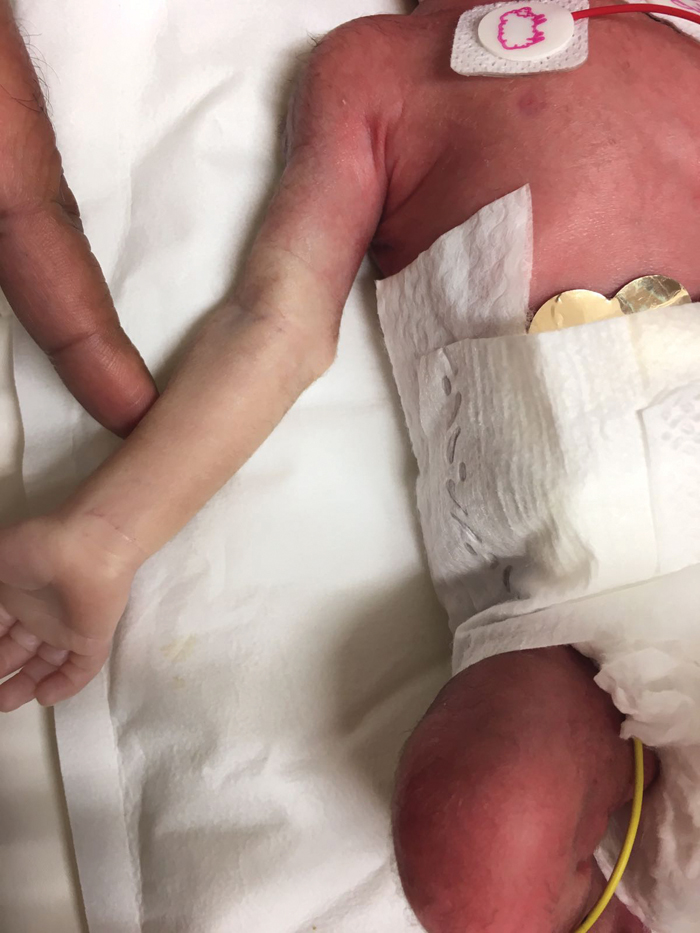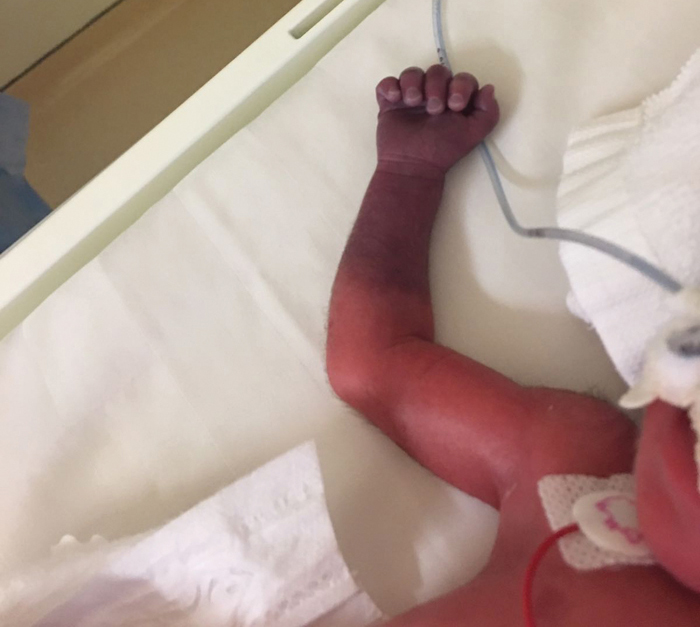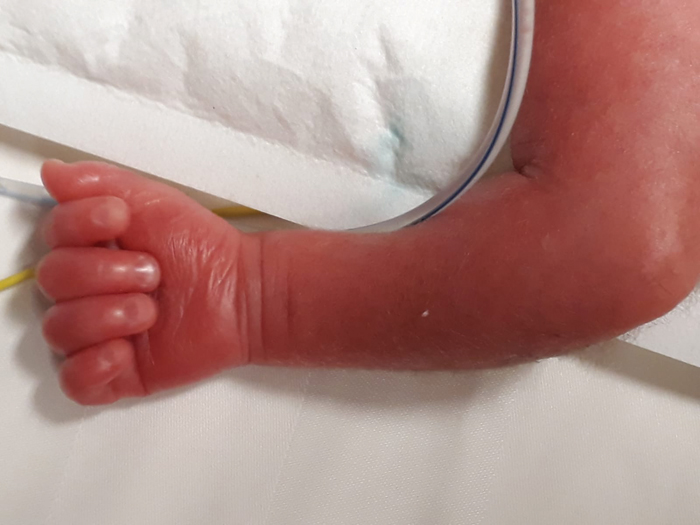Transient peripheral vasospasm in a preterm newborn infant: a case report
This article reports a case of a preterm baby born at 27 weeks’ gestation who developed peripheral arterial spasm of the forearm without any obvious precipitating factors and which was managed conservatively without any sequelae.
Samuel E. Ibhanesebhor
BS, MBBS, DCH, MRCP(UK), FRCP (Glasg), FRCPCH, FWACP, FMC Paed
Consultant Neonatologist1 and Professor of Paediatrics2
samuel.ibhanesebhor@royalehayat.com
Chikkanayakanahalli M. Manjunatha
MBBS, DCH, MD, DNB (Paed), MRCP (UK), FRCPCH
Consultant Neonatologist1
1Neonatology and Newborn Nursery Department, Royale Hayat Hospital, Hawally, Kuwait
2Department of Paediatrics, School of Clinical Medicine, Igbinedion University, Okada, Nigeria
The case
A female preterm baby was born at 27 weeks and 6 days of gestation by emergency caesarean section for placental abruption and fetal distress. The mother was 29 years old, gravida five and para one with three previous miscarriages. She received aspirin during the pregnancy as she was anti-lupus positive. There was no maternal diabetes or any other health conditions. She received a first dose of antenatal steroid 10 minutes before the delivery.
The baby was born in good condition with Apgar scores of 4, 6 and 8 at one, five and 10 minutes of age, respectively. There was retroplacental clot. The baby’s birth weight was 1,144g and her head circumference was 26.5cm. The cord pH was 7.04 with a base deficit of -12.2. The amniotic fluid was meconium stained. There was no difficulty in the extraction of the baby.
The baby was electively intubated and surfactant was administered at seven minutes of age for respiratory distress syndrome. Her admission temperature was 35.8°C and blood sugar was 2.8mmol/L.
At 50 minutes of age, the baby developed sudden complete pallor of the right upper limb below the elbow (FIGURE 1), which changed to dusky (FIGURE 2) then red and resolved completely by 8 hours of age (FIGURE 3). No invasive procedure, including cannulation, was performed in the right arm prior to this episode. The rest of the clinical examination was entirely normal except for weak brachial and radial pulses compared to the unaffected side. The mean blood pressure was 36mmHg and the baby remained haemodynamically stable.

FIGURE 1 The baby developed sudden complete pallor of the right arm below the elbow at age 50 minutes.

FIGURE 2 The pallor became dusky and then dark red.

FIGURE 3 Complete resolution by 8 hours of age.
Differential diagnoses were arterial vasospasm or thromboembolic pheno-mena. The unaffected limb was warmed in an attempt to improve the circulation in the affected limb by reflex vasodilation. Umbilical lines were inserted with heparinised saline to maintain patency of the umbilical arterial line. Lower limb perfusion remained normal. A Doppler study showed a normal axillary artery and the proximal part of the brachial artery with no luminal thrombosis. A cranial ultrasound scan was normal. A coagulation screen was abnormal with a prolonged activated partial thromboplastin time (APTT) of 100 seconds, which corrected with fresh frozen plasma. The haemoglobin level was 15.2g/dL, the platelet count was 150x109/L and the corrected calcium was 2.07mmol/L.
An echocardiogram showed abnormal configuration of the aorta (diagnosed as double aortic arch with subsequent surgery), a moderately sized (2.8mm) patent ductus arteriosus and an atrial septal defect with pulmonary hypertension.
There was no recurrence of vasospasm or tissue damage following this episode. The baby was transferred to a local government hospital for ongoing management of prematurity on day three of life as per parental request. The baby was last seen at five months of age for review and there was no concern about her right arm.
Discussion
Vasospasm refers to the sudden constriction of a blood vessel, causing it to narrow and reducing the amount of blood that flows through it. It can result from either intentional or unintentional manipulation of a blood vessel, as in arterial cannulation or from inadvertent contact during other procedures.1 Insertion of arterial catheters may mechanically damage the vascular endothelium, exposing subendothelial tissue and collagen to the circulating blood. Platelets then adhere and aggregate, releasing adenosine diphosphate and thromboxane A2 (a platelet stimulator and a very potent vasoconstrictor). These events may lead to vasospasm around the catheter insertion site, complete occlusion and tissue ischaemia.2 However, this was not the case with the patient reported here who had no intervention to the vasculature of the upper limbs.
The clinical problems from this disorder range from transient mottling of skin colour to necrosis of important body tissues.1 It is important to perform arterial cannulation/puncture only when absolutely necessary to avoid this complication. There is limited experience in managing this phenomenon in neonates. There are case reports of using tolazoline,1,3 and topical 2% nitroglycerine2,4 to counteract the local arterial vasospasm. Nitroglycerine has an advantage over tolazoline as it is administered topically and can be wiped off if the baby develops hypotension. Vasospasm may be transient and may resolve without any lasting damage, as in this case, or may affect the viability of the distal parts and tissues with devastating consequences. The case presented here demonstrates that vasospasm may occur spontaneously and the transient nature of the clinical course may help us to differentiate vasospasm from thromboembolic phenomena.
Parental consent
The authors obtained written consent from the child’s parents for publication of the case history and images.
Acknowledgement
The authors are grateful for the help of Dr Ahmed Aborahma, Royale Hayat Hospital, Kuwait and the child’s parents for consenting to write this case report.
Or read this article in our
Tablet/iPad edition
- The arterial spasm is a well-known complication of arterial catheterisation in neonates.
- Transient peripheral vasospasm may occur in the preterm baby without any obvious precipitating factors.
Also published in Infant:


